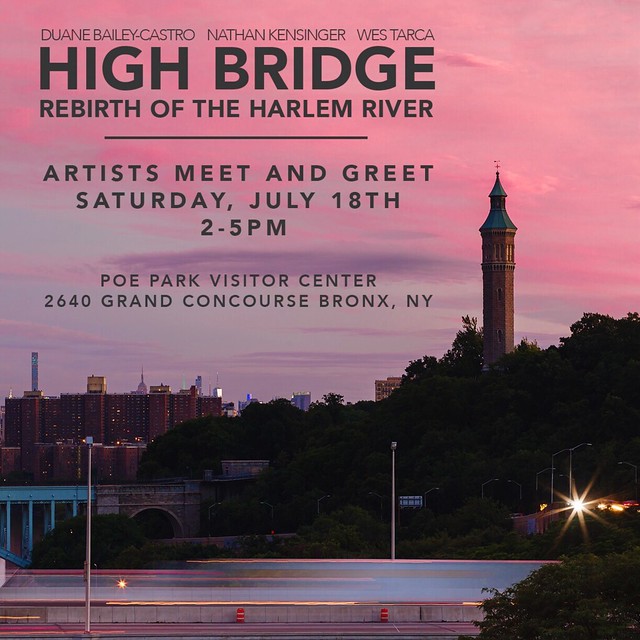Sleeping in the Sommerville Basin

July 31, 2011 -
The Sommerville Basin is a small Jamaica Bay inlet in The Rockaways, located on the border between the Queens neighborhoods of Arverne and Edgemere. Fishermen and crabbers ply its waters from all sides, despite being downshore from the Edgemere Landfill, an abandoned toxic dump which is leeching trash into the bay nearby. A warning sign posted by the NY Department of Health reads "no more than one meal per week of Bluefish, American Eels, or Striped Bass from Jamaica Bay shall be eaten," but that does not seem to deter the fishermen of the basin, who proudly describe catching and grilling fish over three feet long.
They cast their lines in the shadow of the Ocean Bay Apartments, which are more commonly known as the Edgemere Houses, one of New York City's most notorious housing projects. "Cops at one time called [it] "Edgefear" because it was the worst public housing in the city by any indicator you care to choose," according to The Wave. The neighborhood of northern Edgemere, on the eastern side of the Sommerville Basin, is plagued by gang warfare, with abandoned waterfront buildings and marinas covered in gang graffiti. A pack of wild dogs lives in the park behind the Edgemere Houses, near city-owned fishing piers that jut out above the Sommerville Basin.
The main feature of the Sommerville Basin is Marina 59, a small three pier marina primarily used to store fishing vessels. Home to a surplus of abandoned boats, the marina is patrolled by a herd of goats which trim the weeds underneath vessels with names like "Parking Lot Pimp," "Beeracuda," "Like It Wet III," and "Wasting Away - Margarittaville." The marina rents kayaks and motorboats, has a bait shop selling hot coffee and worms, and is surrounded by a razor wire topped fence. With its remote location, "Marina 59 is a money-losing venture," according to the NY Times.
This summer, however, an improbably popular resort has sprung up inside the marina. Named the Boggsville Boatel and Boat-In Theater, it is a small collection of refurbished abandoned boats clustered around a floating platform at the end of a pier. For a donation of $50 to $100 a night, visitors can stay onboard a private vessel, be entertained by either a movie or lecture, and can paddle out into the basin. Created by artist Constance Hockaday, The Boatel has been described as "New York City’s newest and perhaps loopiest tourist outpost," by the NY Times, and is entirely booked for the summer.
Spending a night at The Boatel is surprisingly peaceful. The sounds of the city - jets taking off from JFK, elevated subway trains, traffic from the Edgemere Houses - tend to fade away into the background as gentle waves rock The Boatel platform. Despite its urban setting, the Sommerville Basin is a pleasant and quiet refuge. Several fishermen stay late into the night with their boats.
One hundred years ago, The Rockaways were the main summer escape for New York City, with grand hotels, amusement parks, tent cities and thousands of seasonal bungalows. At its peak, the peninsula was known as "The Playground of New York," according to The Wave, but by the 1960's most of the eastern section of The Rockaways had become blighted by failed development schemes, arson, abandoned bungalows, and "one of the city's highest concentrations of public housing," according to the NY Times. The neighborhoods of Arverne, Edgemere and Far Rockaway - located at the farthest eastern end of the peninsula - were hit the hardest.
These neighborhoods are still struggling to recover today. In recent years, however, redevelopment and gentrification have slowly reached out to transform the The Rockaways. In Far Rockaway, artists have been buying and refurbishing some of the few remaining bungalows. In Arverne, empty blocks are being transformed into Arverne By The Sea - "New York City’s newest and most improbable neighborhood," according to New York Magazine. "Over the last few summers, this sandy and pockmarked peninsula has become an unlikely hangout for young, artsy types," according to the NY Times. It remains to be seen whether the new-found popularity of The Rockways will create permanent change, or whether the artists will all float away when this latest season of summers is over.
---
For more photo essays from The Rockaways, please visit The North Edgemere Shore (2010) The South Edgemere Wasteland (2010), The Edgemere Landfill (2010), Hammels Wye (2010) and Far Rockaway: Abandoned Bungalows (2009).
















































